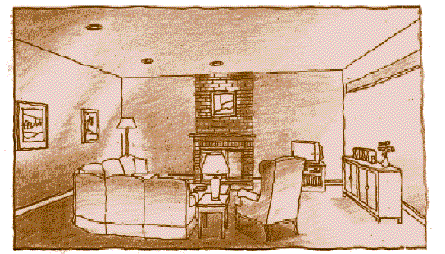Living Room
A variety of activities occur in a living room. General lighting is necessary to allow people to see faces, engage in a conversation, and watch television. Task lighting should be available for reading or sewing, and accent lighting can be used to highlight artwork, plants, or any other interesting features. Lights aimed toward the walls and ceilings can also make the room appear brighter than if light is directed only to the floor. Bare bulbs should be hidden behind shades, architectural features, or opaque surfaces of fixtures.
Design features:
- Two 4-ft long wall-mounted strip lights, each with two fluorescent tubes, mounted behind a wall valance located at least 18 inches (in.) below the ceiling, light the wall and ceiling. The bulbs are 32-watt (W) T8/830 linear fluorescent tubes (CCT of 3000K and CRI of 80) with electronic ballasts.
- Plug-in table and floor lamps to light the reading chairs. The bottom of the floor lamp's shade is located at eye level when seated to minimize glare. Floor lamps should be located behind and slightly to the side of the reader. These lamps use 25- to 30W Energy Star labeled screwbase compact fluorescent bulbs or 75- to 100-W halogen incandescent bulbs. Table and floor lamps designed for 68-W metal halide bulbs can also be used. These metal halide bulbs provide a lot of light, but take several minutes to reach full brightness.
- Adjustable downlights, recessed in the ceiling, highlight objects on the wall, and provide brightness to the space. They are installed 1 to 2 ft from the wall and aimed at the paintings and hearth. These downlights have grooved baffles, and use 50-W Parabolic Aluminized Reflector (PAR) 20 or PAR 30 halogen floodlights.



